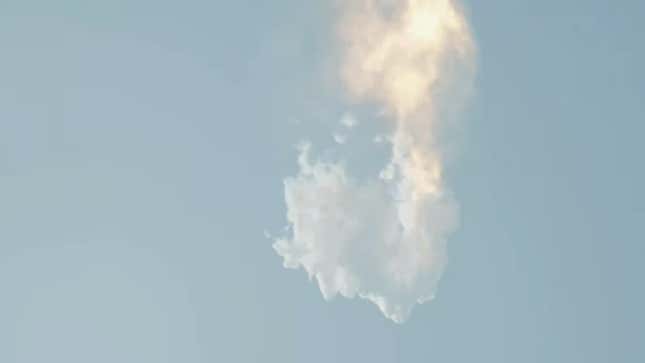It lastly occurred—and it was as spectacular as we hoped. SpaceX’s Starship megarocket blasted off from the Boca Chica, Texas, launch pad simply after 9:30 a.m. ET this morning, lifted upwards by a record-breaking quantity of thrust.
Starship shouldn’t be but prepared for prime time, however by lastly chickening out on Thursday, the megarocket is now within the report books as being the largest, tallest, and strongest rocket to take flight. This was a take a look at flight, and SpaceX wished to see simply how far they might take it, so having the rocket final for practically 4 minutes represents an unbelievable accomplishment.
The rocket cleared the launch tower and managed to outlive MaxQ, the second when a rocket experiences the best aerodynamic stress, and continued upwards towards area. Issues turned bitter shortly earlier than the four-minute mark, nevertheless, when the rocket started to exhibit erratic flight conduct. The rocket blew up, presumably the results of a self-destruct command issued by SpaceX floor management.
Starship was roughly 37 miles (60 kilometers) above the Gulf of Mexico when it started to tumble. Because the Kármán line begins at 62 miles (100 km) above the floor, it can’t be mentioned that Starship entered area. For this mission, SpaceX stacked Starship prototype 24 onto Tremendous Heavy booster 7 prototype. Each parts have been destroyed throughout the take a look at flight, which failed shortly earlier than the stage separation part of launch.

Launch preparations, together with the loading of 10 million kilos of cryogenic liquid propellant, unfolded this morning with none critical points rising. Shortly earlier than launch, SpaceX commentator John Insprucker mentioned groups managed to resolve a booster tanking pressurization subject, whereas additionally having to take care of some last purging within the higher stage. The launch was briefly placed on maintain on the T-40 second mark, permitting the groups to carry out last checkouts.
The launched resumed shortly thereafter, with the methane-powered 33 Raptor engines igniting in banks, or clusters, the primary set of which erupted at T-6 seconds. The rocket rose upwards, clearing the tower and producing an unusually sooty and brown plume.
Because the rocket ascended, a number of shiny flashes appeared on the base of the Tremendous Heavy booster—a possible signal of some Raptor engines truly fizzling out throughout the launch. As many as three failed throughout the first 15 seconds, with one other 4 or 5 failing deeper into the short-lived mission. A graphic proven throughout SpaceX’s stay protection, displaying a number of unlit Raptors, matched the visuals of the rocket itself.
Had all 33 Raptors ignited, the rocket would’ve produced roughly 16.5 million kilos of thrust. Nonetheless, with even a small portion of the engines not firing, the launch is bound to lead to a brand new lifting-power report. We’re wanting ahead to SpaceX offering clarification on this, and the explanation for the sooty plume. Starship additionally appeared to shimmy horizontally after clearing the tower, which additionally requires a proof.
A priority heading into the launch was whether or not the jumbo rocket may trigger injury to 469-foot-tall (142 meters) launch and catch tower and surrounding infrastructure. The launch web site appears comparatively unscathed, however we await additional affirmation from SpaceX within the coming days.
Starship is a two-stage rocket that SpaceX will use to move crews, cargo, and spacecraft to Earth orbit, the Moon, Mars, and different locations. Because the rocket is designed for full reusability, and since it’s so highly effective, Starship represents a revolutionary subsequent step for heavy-lift launch autos. NASA has a vested curiosity in Starship, because the area company is planning to make use of the higher stage as a veritable elevator for transporting crews right down to the lunar floor throughout upcoming Artemis missions.
For the maiden flight of Starship, SpaceX had deliberate for the higher stage to fly so far as Hawaii and crash into the Pacific Ocean, and have the booster fall into the Gulf of Mexico. The mission lasted for 4 minutes and never the hoped 90 minutes, however that is nonetheless an incredible outcome.
SpaceX was merely hoping to see the rocket depart the Boca Chica launch tower, so every little thing that occurred afterwards ought to be thought of a bonus. That mentioned, the inaugural flight did lead to some very curious and doubtlessly problematic behaviors that CEO Elon Musk’s non-public area firm must kind out. SpaceX, it’s honest to say, nonetheless has numerous work to do to make Starship a totally operational and reusable heavy-lift launch automobile.
This text is a part of a growing story. Our writers and editors will probably be updating this web page as new data is offered. Please verify again once more in a couple of minutes to see the most recent updates. In the meantime, if you’d like extra information protection, take a look at our tech, science, or io9 entrance pages. And you may all the time see the latest Gizmodo information tales at gizmodo.com/latest.
Trending Merchandise

Cooler Master MasterBox Q300L Micro-ATX Tower with Magnetic Design Dust Filter, Transparent Acrylic Side Panel, Adjustable I/O & Fully Ventilated Airflow, Black (MCB-Q300L-KANN-S00)

ASUS TUF Gaming GT301 ZAKU II Edition ATX mid-Tower Compact case with Tempered Glass Side Panel, Honeycomb Front Panel, 120mm Aura Addressable RGB Fan, Headphone Hanger,360mm Radiator, Gundam Edition

ASUS TUF Gaming GT501 Mid-Tower Computer Case for up to EATX Motherboards with USB 3.0 Front Panel Cases GT501/GRY/WITH Handle

be quiet! Pure Base 500DX ATX Mid Tower PC case | ARGB | 3 Pre-Installed Pure Wings 2 Fans | Tempered Glass Window | Black | BGW37

ASUS ROG Strix Helios GX601 White Edition RGB Mid-Tower Computer Case for ATX/EATX Motherboards with tempered glass, aluminum frame, GPU braces, 420mm radiator support and Aura Sync









